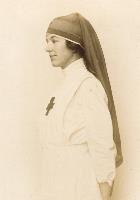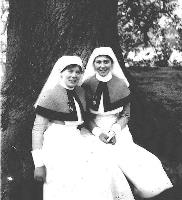Recognising the work and contribution of women to the story of Plastic Surgery
8th March 2022
For International Women's Day 2022 we've put together a showcase of our material to highlight some of the historic women who feature in The BAPRAS Collection, and recognise their contribution to the story of plastic surgery.
 Emerin Keene
Emerin Keene
In 1918 she worked as a Red Cross Nurse, alongside Dental Surgeon, Amedeo Perna in the Ospedale Stomatoiatrico, located in Villa Massimo, Rome. The Ospedale Stomatoiatrico was a hospital devoted to plastic work around facial injuries, the soldiers featured here have suffered shrapnel wounds. Keene wrote a diary of her experiences working in the hospital and took a photographic record of soldiers treated there. Her material is important because it highlights the work being done in Italy around facial reconstruction at this time. It also acted as an important advocacy tool for the fledgling specialty that was plastic surgery. She shows soldiers before and after reconstructive treatment in her images, which has a powerful impact and provided further testimony as to the benefits and success that plastic surgeons at the time were achieving.
Diana Orpen
Commonly known as ‘ Dickie’ Orpen, she originally trained as a nurse but left this vocation to focus on her drawing. Orpen wanted to contribute to the war effort and was able to use her drawings to do this. She worked alongside surgeons at Hill End Hospital, St Albans sketching and drawing the procedures performed by surgeons such as Rainsford Mowlem. Her drawings and sketch books offer a comprehensive record of plastic surgery techniques being performed, developed and perfected at this time. However, they are important in another way. They are beautiful, no doubt, but they are also very accurate and technical which was arguably their primary function. These drawings were used by surgeons to review, share, discuss and perfect surgical techniques. In this way they have supported the specialty in developing and improving, as it continues to do today.
 Sidcup Nurses
Sidcup Nurses
The BAPRAS Collection has a large photographic collection from Queen Mary’s Hospital, Sidcup which was one of, if not the first, dedicated plastic surgery hospital at the time. The collection features soldiers at leisure in between operations. One of the most striking things about the collection is the prevalence of the nurses. They feature very heavily, often in groups with soldiers. Their strong presence is indicative of the importance attached to them by the soldiers and the surgeons. At Sidcup, Gillies was not only pioneering surgical procedures but also a rehabilitation process; recognising the importance of rest, calm, fresh air and social interaction as benefitting mental and physical wellbeing. The nurses at Sidcup played an integral part in this rehabilitation.
The showcase is displayed on the 4th floor of the Royal College of Surgeons of England building.
We would like to hear from women!
Our Collection has a notable gap relating to female surgeons and this is not right. Please share your experiences of being a woman in this specialty, or share your experience of the specialty irrespective of being a woman. If you have something relating to your practice or professional experiences which you think should be preserved for study and posterity; or you have a story to tell then please get in touch.
Back to list page